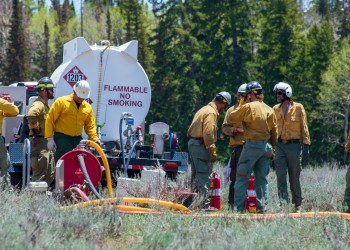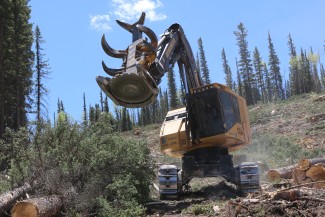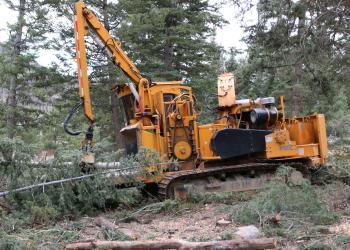Management
Fishlake National Forest Fire Management encompasses a wide range of programs aimed at preventing and suppressing wildfires, as well as managing fire's role in maintaining healthy ecosystems. This includes fire prevention, pre-suppression preparedness, wildfire suppression, and post-fire recovery efforts. The Forest Service also collaborates with other agencies and communities to reduce wildfire risk and protect lives and property.
Fire Management
Fire Science

Science has changed the way we think about wildland fire and the way we manage it. We still suppress fires, especially if they threaten people and communities, and we understand that fire has a role in nature - one that can lead to healthy ecosystems. We look for ways to manage it to play its role, for instance, by planning and implementing prescribed fires, or managing fires utilizing a variety of tactics to meet multiple objectives.
National Cohesive Wildland Fire Management Strategy

The Forest Service conducts cutting-edge research and develops tools to help land managers better understand and manage fires. Our scientists study the behavior and the effects of fire on ecosystems and society, as well as offer management options.
Fuels Management

Fuel is the combustible material found in forests that feeds wildfires. Fuels include everything from needles, grasses, and small twigs (fine fuels) to progressively larger pieces such as shrubs, branches on the ground, downed trees, and logs. Fuels management includes treatments across the Fishlake National Forest that have been implemented to reduce and/or redistribute ground, surface, and canopy fuels by removing trees, and masticating (shredding) small diameter trees and shrubs.

Forest and rangeland fuel treatments are achieved using either prescribed fire, mechanical treatment, or a combination of the two. Prior to implementing prescribed fire or mechanical treatments, local units must have ensured compliance with National Environmental Policy Act (NEPA), National Historic Preservation Act (NHPA), and Endangered Species Act (ESA) requirements. An effective fuel treatment will slow the spread of fire and reduce the likelihood of crown fire (fire that spreads across the tops of trees rather than from the ground up), aid fire suppression efforts, and reduce the severity of a wildfire under all but the most extreme weather conditions.

Much like a doctor determines a patient’s course of treatment, land managers evaluate the conditions of an ecosystem and determine the best treatment method to create a more resilient landscape. Fire is often prescribed to remove dead and overgrown vegetation to reduce wildfire risk to communities, infrastructure, and watersheds, improve wildlife habitat, and increase overall health of the forest and/or grassland. Land management agencies are using prescribed fire to maintain and improve the long-term resiliency of these landscapes and ecosystems that have evolved with fire.
Fuel Treatments
Prescribed Fire

Fire is an important and essential ecological process in many adapted ecosystems. In large areas of the country, fire exclusion from the ecosystems has led to unhealthy forests, woodlands, and rangeland conditions. These areas are at risk of intense, severe wildfires that threaten communities and cause significant damage to key ecological components. Fire managers use prescribed fire to mimic the natural role of fire on the landscape which can help to maintain and restore the condition and function of ecosystems, and to reduce wildfire risk. This work, in turn, assists fire responders in protecting communities, property, and infrastructure in the event of an unwanted wildfire. Prescribed fires are carefully planned and managed to reduce wildfire risk while minimizing potential environmental, economic and public health impacts. Benefits of prescribed fire over unwanted wildfire include the ability of managers to plan for it, identify the parameters and conditions desired for implementation of the burn, and minimize the smoke impacts.
Learn more about planned, on-going and completed prescribed fire operations across the USDA Forest Service Intermountain Region by clicking the link below
Mechanical Treatments

Mechanical treatment of hazardous fuels means reducing the amount of vegetation which has built up to dangerous levels or changing the arrangement of these fuels in the environment. Mechanical treatments implemented on the Fishlake National Forest can benefit ecosystems and people by:
- Reducing the probability of catastrophic fires by modifying fire behavior
- Improving forest health and resilience
- Increasing understory diversity
- Restoring natural ecosystem processes
- Supporting wildlife
Examples of mechanical treatment include the thinning of dense stands of trees, or other fuel treatments that make an area better able to withstand fire. Such treatments might be piling brush, pruning lower branches of trees, or creating fuel breaks to encourage the right kind of fire. Tools that are used to carry out the mechanical treatment of hazardous fuels range from hand tools such as chainsaws and rakes to large machines like bulldozers and woodchippers. Mechanical treatment can be used on its own or together with prescribed burning to modify fire behavior so when a fire does burn through a treated area, it is less destructive, less costly, and easier to contain. Often, mechanical fuels treatments are followed by prescribed fire to create effective hazard reduction.


